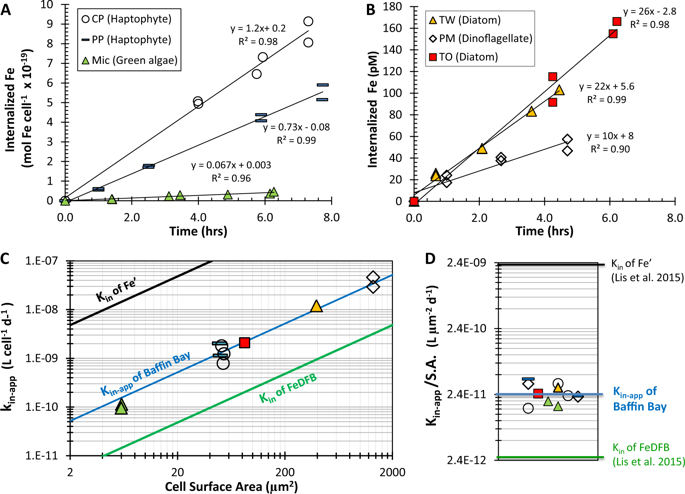Our official English website, www.x-mol.net, welcomes your
feedback! (Note: you will need to create a separate account there.)
Insights into the bioavailability of oceanic dissolved Fe from phytoplankton uptake kinetics.
The ISME Journal ( IF 10.8 ) Pub Date : 2020-02-05 , DOI: 10.1038/s41396-020-0597-3 Yeala Shaked 1, 2 , Kristen N Buck 3 , Travis Mellett 3 , Maria T Maldonado 4
The ISME Journal ( IF 10.8 ) Pub Date : 2020-02-05 , DOI: 10.1038/s41396-020-0597-3 Yeala Shaked 1, 2 , Kristen N Buck 3 , Travis Mellett 3 , Maria T Maldonado 4
Affiliation

|
Phytoplankton growth in large parts of the world ocean is limited by low availability of dissolved iron (dFe), restricting oceanic uptake of atmospheric CO2. The bioavailability of dFe in seawater is however difficult to appraise since it is bound by a variety of poorly characterized organic ligands. Here, we propose a new approach for evaluating seawater dFe bioavailability based on its uptake rate constant by Fe-limited cultured phytoplankton. We utilized seven phytoplankton species of diverse classes, sizes, and provenances to probe for dFe bioavailability in 12 seawater samples from several ocean basins and depths. All tested phytoplankton acquired organically bound Fe in any given sample at similar rates (after normalizing to cellular surface area), confirming that multiple, Fe-limited phytoplankton species can be used to probe dFe bioavailability in seawater. These phytoplankton-based uptake rate constants allowed us to compare water types, and obtain a grand average estimate of seawater dFe bioavailability. Among water types, dFe bioavailability varied by approximately four-fold, and did not clearly correlate with Fe concentrations or any of the measured Fe speciation parameters. Compared with well-studied Fe complexes, seawater dFe is more available than model siderophore Fe, but less available than inorganic Fe. Exposure of seawater to sunlight, however, significantly enhanced dFe bioavailability. The rate constants established in this work, not only facilitate comparison between water types, but also allow calculation of Fe uptake rates by phytoplankton in the ocean based on measured dFe concentrations. The approach established and verified in this study, opens a new way for determining dFe bioavailability in samples across the ocean, and enables modeling of in situ Fe uptake rates by phytoplankton using dFe concentrations from GEOTRACES datasets.
中文翻译:

从浮游植物吸收动力学深入了解海洋溶解铁的生物利用度。
世界海洋大部分地区的浮游植物生长受到溶解铁 (dFe) 利用率低的限制,从而限制了海洋对大气二氧化碳的吸收。然而,dFe 在海水中的生物利用度很难评估,因为它与各种特征较差的有机配体结合。在这里,我们提出了一种根据有限铁培养浮游植物的吸收率常数来评估海水 dFe 生物利用度的新方法。我们利用七种不同类别、大小和来源的浮游植物物种来探测来自多个洋盆和深度的 12 个海水样本中的 dFe 生物利用度。所有测试的浮游植物在任何给定样品中都以相似的速率(在标准化为细胞表面积后)获得有机结合的铁,证实多种铁限制的浮游植物物种可用于探测海水中的 dFe 生物利用度。这些基于浮游植物的吸收率常数使我们能够比较水类型,并获得海水 dFe 生物利用度的总体平均估计。在水类型中,dFe 生物利用度变化约四倍,并且与 Fe 浓度或任何测量的 Fe 形态参数没有明显的相关性。与充分研究的 Fe 配合物相比,海水 dFe 的利用率高于模型铁载体 Fe,但低于无机 Fe。然而,将海水暴露在阳光下会显着提高 dFe 的生物利用度。这项工作中建立的速率常数不仅有助于水类型之间的比较,而且还可以根据测量的 dFe 浓度计算海洋中浮游植物的 Fe 吸收率。本研究中建立和验证的方法开辟了一种确定整个海洋样品中 dFe 生物利用度的新方法,并能够使用 GEOTRACES 数据集中的 dFe 浓度对浮游植物的原位 Fe 吸收率进行建模。
更新日期:2020-02-06
中文翻译:

从浮游植物吸收动力学深入了解海洋溶解铁的生物利用度。
世界海洋大部分地区的浮游植物生长受到溶解铁 (dFe) 利用率低的限制,从而限制了海洋对大气二氧化碳的吸收。然而,dFe 在海水中的生物利用度很难评估,因为它与各种特征较差的有机配体结合。在这里,我们提出了一种根据有限铁培养浮游植物的吸收率常数来评估海水 dFe 生物利用度的新方法。我们利用七种不同类别、大小和来源的浮游植物物种来探测来自多个洋盆和深度的 12 个海水样本中的 dFe 生物利用度。所有测试的浮游植物在任何给定样品中都以相似的速率(在标准化为细胞表面积后)获得有机结合的铁,证实多种铁限制的浮游植物物种可用于探测海水中的 dFe 生物利用度。这些基于浮游植物的吸收率常数使我们能够比较水类型,并获得海水 dFe 生物利用度的总体平均估计。在水类型中,dFe 生物利用度变化约四倍,并且与 Fe 浓度或任何测量的 Fe 形态参数没有明显的相关性。与充分研究的 Fe 配合物相比,海水 dFe 的利用率高于模型铁载体 Fe,但低于无机 Fe。然而,将海水暴露在阳光下会显着提高 dFe 的生物利用度。这项工作中建立的速率常数不仅有助于水类型之间的比较,而且还可以根据测量的 dFe 浓度计算海洋中浮游植物的 Fe 吸收率。本研究中建立和验证的方法开辟了一种确定整个海洋样品中 dFe 生物利用度的新方法,并能够使用 GEOTRACES 数据集中的 dFe 浓度对浮游植物的原位 Fe 吸收率进行建模。











































 京公网安备 11010802027423号
京公网安备 11010802027423号